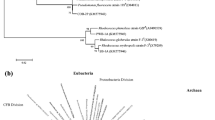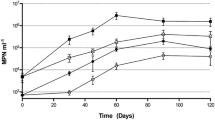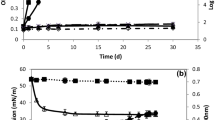Abstract
The risk of hydrocarbon contamination in marine polar areas is constantly increasing. Autochthonous bacteria, due to their ability to cope and survive under extreme environmental conditions, can play a fundamental role in the hydrocarbon degradation. The degradation process is often enhanced by the production of biosurfactant molecules. The present study reports for the first time on the isolation of biosurfactant-producing bacteria from Arctic and Antarctic shoreline sediments. A total of 199 psychrotolerant bacterial isolates were obtained from hydrocarbon-amended (with crude or diesel oil) microcosms. A total of 18 isolates were selected for their ability to grow in the presence of crude oil and produce biosurfactants, as it was revealed by the production of good E24 values (≥50 %) and/or reduction in the surface tension (under 30 mN/m). The positive response of the isolates to both tests suggests a possible production of biosurfactants with emulsifying and interfacial activities. Biosurfactant-producing isolates were mainly affiliated to the genera Rhodococcus (14 isolates), followed by Pseudomonas (two isolates), Pseudoalteromonas (one isolate) and Idiomarina (one isolate). Thin-layer chromatography of biosurfactant crude extracts revealed that the majority of the selected isolates were able to produce glycolipidic surfactants. Our results enlarge the knowledge, which is still poor and fragmentary, on biosurfactant producers from polar areas and indicate marine polar sediments as a source of bacteria with potential applications in the remediation of hydrocarbon-contaminated cold environments.

Similar content being viewed by others
References
Batista SB, Mounteer AH, Amorim FR, Tótola MR (2006) Isolation and characterization of biosurfactant/bioemulsifier-producing bacteria from petroleum contaminated sites. Bioresour Technol 97:868–875
Bej AK, Saul D, Aislabie J (2000) Cold-tolerant alkane-degrading Rhodococcus species from Antarctica. Polar Biol 23:100–105
Bodour AA, Maier M (1998) Application of a modified drop-collapse technique for surfactant quantification and screening of biosurfactant-producing microorganisms. J Microbiol Meth 32:273–280
Bozal N, Manresa A, Castellvi J, Guinea J (1994) A new bacterial strain of Antarctica, Alteromonas sp., that produces a heteropolymer slime. Polar Biol 14:561–567
Cai Q, Zhang B, Chen B, Zhu Z, Lin W, Cao T (2014) Screening of biosurfactant producers from petroleum hydrocarbon contaminated sources in cold marine environments. Mar Poll Bull 86:402–410
Cameotra SS, Makkar RS, Kaur J, Mehta SK (2010) Synthesis of biosurfactants and their advantages to microorganisms and mankind. Adv Exp Med Biol 672:261–280
Carrillo PG, Mardaraz C, Pitta-Alvarez SJ, Giulietti AM (1996) Isolation and selection of biosurfactant-producing bacteria. World J Microbiol Biotechnol 12:82–84
Coelho J, Rivonkar CU, Bhavesh NS, Jothi M, Sagodkar UM (2003) Biosurfactant production by the quinoline degrading marine bacterium Pseudomonas sp. strain GU 104, and its effect on the metabolism of green mussel Perna viridis L. Indian J Mar Sci 32:202–207
Cooper DG, Zajic JE, Gerson DF (1979) Production of surface active lipids by Corynebacterium lepus. Appl Environ Microbiol 37:4–10
De Domenico M, Lo Giudice A, Michaud L, Saitta M, Bruni V (2004) Diesel oil and PCB-degrading bacteria isolated from Antarctic seawaters (Terra Nova Bay, Ross Sea). Polar Res 23:141–146
Deppe U, Richnow H-H, Michaelis W, Antranikian G (2005) Degradation of crude oil by an Arctic microbial consortium. Extremophiles 9:461–470
Desai JD, Banat IM (1997) Microbial production of surfactants and their commercial potential. Microbiol Mol Biol R 61:47–64
Ellaiah P, Prabhakar T, Sreekanth M, Taleb AT, Raju PB, Saisha V (2002) Production of glycolipids containing biosurfactant by Pseudomonas species. Indian J Exp Biol 40:1083–1086
Gerdes B, Brinkmeyer R, Dieckmann G, Helmke E (2005) Influence of crude oil on changes of bacterial community in Arctic sea-ice. FEMS Microbiol Ecol 53:129–139
Gutierrez T, Shimmield T, Haidon C, Black K, Green DH (2008) Emulsifying and metal ion binding activity of a glycoprotein exopolymer produced by Pseudoalteromonas sp. strain TG12. Appl Environ Microbiol 74:4867–4876
Husain DR, Goutx M, Acquaviva M, Gilewicz M, Bertrand JC (1997) The effect of temperature on eicosane substrate uptake modes by a marine bacterium Pseudomonas nautica strain 617: relationship with the biochemical content of cells and supernatants. World J Microbiol Biotechnol 13:587–590
Johnson MK, Boese-Marrazzo D (1980) Production and properties of heat stable extracellular hemolysin from Pseudomonas aeruginosa. Infect Immun 29:1028–1033
Kiran SG, Anto T, Selvin J, Sabarathnam B, Lipton AP (2010) Optimization and characterization of a new lipopeptide biosurfactant produced by marine Brevibacterium aureum MSA13 in solid state culture. Bioresour Technol 101:2389–2396
Labbè D, Margesin R, Schinner F, Whyte LG, Greer CW (2007) Comparative phylogenetic analysis of microbial communities in pristine and hydrocarbon-contaminated Alpine soils. FEMS Microbiol Ecol 59:466–475
Lang S (2002) Biological amphiphiles (microbial biosurfactants). Curr Opin Colloid Interface Sci 7:12–20
Lo Giudice A, Casella P, Caruso C, Mangano S, Bruni V, De Domenico M, Michaud L (2010) Occurrence and characterization of psychrotolerant hydrocarbon–oxidizing bacteria from surface seawater along the Victoria Land coast (Antarctica). Polar Biol 33:929–943
Lo Giudice A, Caruso C, Mangano S, Bruni V, De Domenico M, Michaud L (2012) Marine bacterioplankton diversity and community composition in an Antarctic coastal environment. Microb Ecol 63:210–223
Maier RM (2003) Biosurfactants: evolution and diversity in bacteria. Adv Appl Microbiol 52:101–121
Mancuso NCA, Garon S, Bowman JP, Raguenes G, Guezennec J (2004) Production of exopolysaccharides by Antarctic marine bacterial isolates. J Appl Microbiol 96:1057–1066
Mancuso NC, Lardiere SG, Bowman JP, Nichols PD, Gibson JAE, Guezennec J (2005) Chemical characterization of exopolysaccharides from Antarctic marine bacteria. Microb Ecol 49:578–589
Michaud L, Lo Giudice A, Saitta M, De Domenico M, Bruni V (2004) The biodegradation efficiency on diesel oil by two psychrotrophic Antarctic marine bacteria during a two-month-long experiment. Mar Poll Bull 49:405–409
Moran M, Martinez A, Sineriz F (2002) Quantification of surfactin in culture supernatant by hemolytic activity. Biotechnol Lett 24:177–180
Morita RY (1975) Psychrophilic bacteria. Bacteriol Rev 39:144–167
Pepi M, Cesarò A, Liut G, Baldi F (2005) An Antarctic psychrotrophic bacterium Halomonas sp ANT-3b, growing on n-hexadecane, produces a new emulsyfying glycolipid. Microb Ecol 53:157–166
Pini F, Grossi C, Nereo S, Michaud L, Lo Giudice A, Bruni V, Baldi F, Fani R (2007) Molecular and physiological characterisation of psychrotrophic hydrocarbon-degrading bacteria isolated from Terra Nova Bay (Antarctica). Eur J Soil Biol 43:368–379
Plaza GA, Ireneusz Z, Banat IM (2006) Use of different methods for detection ofthermophilic biosurfactant producing bacteria from hydrocarbon contaminated and bioremediated soils. J Petrol Sci Eng 50:71–77
Putheti RR, Patil MC (2009) Pharmaceutical formulation development of floating and swellable sustained drug delivery systems: a review. EJ Sci Technol 4:1–12
Rizzo C, Michaud L, Hörmann B, Gerçe B, Syldatk C, Hausmann R, De Domenico E, Lo Giudice A (2013) Bacteria associated with sabellids (Polychaeta: Annelida) as a novel source of surface active compounds. Mar Poll Bull 70:125–133
Rosenberg E, Ron EZ (1999) High and low molecular mass microbial surfactants. Appl Microbiol Biotechnol 52:154–162
Ruberto LAM, Vazquez S, Lobalbo A, Mac Cormack WP (2005) Psychrotolerant hydrocarbon-degrading Rhodococcus strains isolated from polluted Antarctic soils. Antarct Sci 17:47–56
Satpute SK, Bhawsar BD, Dhakephalkar PK, Chopade BA (2008) Assessment of different screening methods for selecting biosurfactant producing marine bacteria. Indian J Mar Sci 37:243–250
Satpute SK, Banpurkar AG, Dhakephalkar PK, Banat IM, Chopade BA (2010) Methods for investigating biosurfactants and bioemulsifiers: a review. Crit Rev Biotechnol 30:127–144
Saul DJ, Aislabie JM, Brown CE, Harris L, Foght JM (2005) Hydrocarbon contamination changes the bacterial diversity of soil around Scott Base, Antarctica. FEMS Microbiol Ecol 53:141–155
Schulz D, Passeri A, Schmidt M, Lang S, Wagner F, Wray V, Gunkel W (1991) Marine biosurfactants, I. Screening for biosurfactants among crude oil degrading marine microorganisms from the North Sea. Z Naturforsch 46:197–203
Syldatk C, Lang S, Wagner F, Wray V, Witte L (1985) Chemical and physical characterization of four interfacial-active rhamnolipids from Pseudomonas spec. DSM 2874 grown on n-alkanes. Z Naturforsch 40:51–60
Whyte LG, Schultz A, van Beilen JB, Luz AP, Pellizzari V, Labbè D, Greer CW (2002) Prevalence on alkane monooxygenase genes in Arctic and Antarctic hydrocarbon-contaminated and pristine soils. FEMS Microbiol Ecol 41:141–150
Yakimov MM, Giuliano L, Bruni V, Scarfì S, Golyshin PN (1999) Characterization of Antarctic hydrocarbon-degrading bacteria capable of producing bioemulsifiers. New Microbiol 22:249–259
Yakimov MM, Gentile G, Bruni V, Cappello S, D’Auria G, Golyshin PN, Giuliano L (2004) Crude oil-induced structural shift of coastal bacterial communities of Rod Bay (Terra Nova Bay, Ross Sea) and characterization of cultured cold-adapted hydrocarbonoclastic bacteria. FEMS Microbiol Ecol 49:419–432
Youssef N, Duncan KE, Nagle D, Savage KN, Knapp R, McInerney MJ (2004) Comparison of methods to detect biosurfactant production by diverse microorganisms. J Microbiol Methods 56:339–347
Acknowledgments
ALG wishes to thank the Antarctic Project “Limnopolar” (POL2006-06635) funded by the Spanish Ministry of Science and Technology, and all colleagues at the Byers camp for their logistic and friendly support to Luigi Michaud during his stay. RM wishes to thank all the colleagues at the Karlsruher Institut für Technologie (KIT), Germany, for assistance and support during her stay in their lab. This research was supported by grants by the project PolyArc (grant number ARCFAC-026129-2008-70) and the National Antarctic Museum (MNA).
Author information
Authors and Affiliations
Corresponding author
Rights and permissions
About this article
Cite this article
Malavenda, R., Rizzo, C., Michaud, L. et al. Biosurfactant production by Arctic and Antarctic bacteria growing on hydrocarbons. Polar Biol 38, 1565–1574 (2015). https://doi.org/10.1007/s00300-015-1717-9
Received:
Revised:
Accepted:
Published:
Issue Date:
DOI: https://doi.org/10.1007/s00300-015-1717-9




